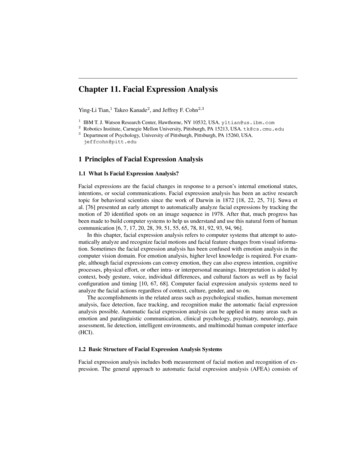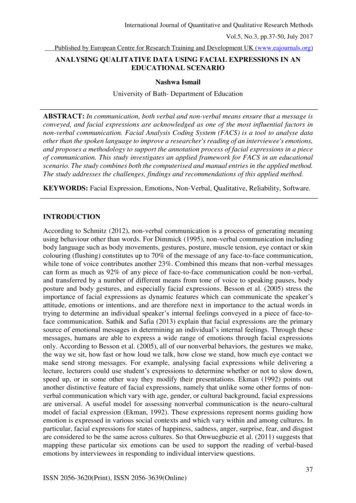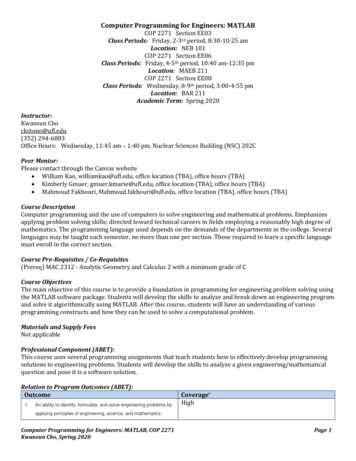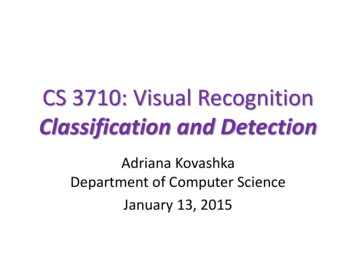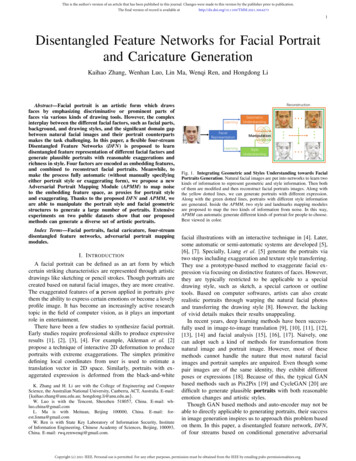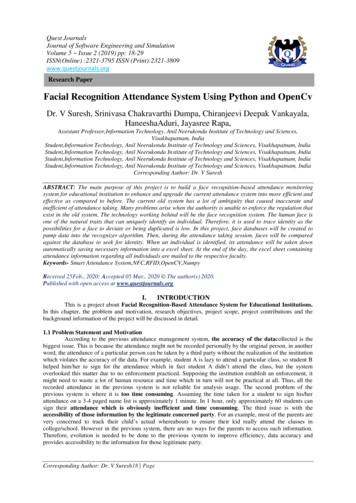
Transcription
Quest JournalsJournal of Software Engineering and SimulationVolume 5 Issue 2 (2019) pp: 18-29ISSN(Online) :2321-3795 ISSN (Print):2321-3809www.questjournals.orgResearch PaperFacial Recognition Attendance System Using Python and OpenCvDr. V Suresh, Srinivasa Chakravarthi Dumpa, Chiranjeevi Deepak Vankayala,HaneeshaAduri, Jayasree Rapa,Assistant Professor,Information Technology, Anil Neerukonda Institute of Technology and Sciences,Visakhapatnam, IndiaStudent,Information Technology, Anil Neerukonda Institute of Technology and Sciences, Visakhapatnam, IndiaStudent,Information Technology, Anil Neerukonda Institute of Technology and Sciences, Visakhapatnam, IndiaStudent,Information Technology, Anil Neerukonda Institute of Technology and Sciences, Visakhapatnam, IndiaStudent,Information Technology, Anil Neerukonda Institute of Technology and Sciences, Visakhapatnam, IndiaCorresponding Author: Dr. V SureshABSTRACT: The main purpose of this project is to build a face recognition-based attendance monitoringsystem for educational institution to enhance and upgrade the current attendance system into more efficient andeffective as compared to before. The current old system has a lot of ambiguity that caused inaccurate andinefficient of attendance taking. Many problems arise when the authority is unable to enforce the regulation thatexist in the old system. The technology working behind will be the face recognition system. The human face isone of the natural traits that can uniquely identify an individual. Therefore, it is used to trace identity as thepossibilities for a face to deviate or being duplicated is low. In this project, face databases will be created topump data into the recognizer algorithm. Then, during the attendance taking session, faces will be comparedagainst the database to seek for identity. When an individual is identified, its attendance will be taken downautomatically saving necessary information into a excel sheet. At the end of the day, the excel sheet containingattendance information regarding all individuals are mailed to the respective faculty.Keywords- Smart Attendance System,NFC,RFID,OpenCV,NumpyReceived 25Feb., 2020; Accepted 05 Mar., 2020 The author(s) 2020.Published with open access at www.questjournals.orgI.INTRODUCTIONThis is a project about Facial Recognition-Based Attendance System for Educational Institutions.In this chapter, the problem and motivation, research objectives, project scope, project contributions and thebackground information of the project will be discussed in detail.1.1 Problem Statement and MotivationAccording to the previous attendance management system, the accuracy of the datacollected is thebiggest issue. This is because the attendance might not be recorded personally by the original person, in anotherword, the attendance of a particular person can be taken by a third party without the realization of the institutionwhich violates the accuracy of the data. For example, student A is lazy to attend a particular class, so student Bhelped him/her to sign for the attendance which in fact student A didn‟t attend the class, but the systemoverlooked this matter due to no enforcement practiced. Supposing the institution establish an enforcement, itmight need to waste a lot of human resource and time which in turn will not be practical at all. Thus, all therecorded attendance in the previous system is not reliable for analysis usage. The second problem of theprevious system is where it is too time consuming. Assuming the time taken for a student to sign his/herattendance on a 3-4 paged name list is approximately 1 minute. In 1 hour, only approximately 60 students cansign their attendance which is obviously inefficient and time consuming. The third issue is with theaccessibility of those information by the legitimate concerned party. For an example, most of the parents arevery concerned to track their child‟s actual whereabouts to ensure their kid really attend the classes incollege/school. However in the previous system, there are no ways for the parents to access such information.Therefore, evolution is needed to be done to the previous system to improve efficiency, data accuracy andprovides accessibility to the information for those legitimate party.Corresponding Author: Dr. V Suresh18 Page
Facial Recognition Attendance System Using Python And OpenCv1.2 Research ObjectivesIn order to solve the drawbacks of the previous system stated in 1.1, the existing system will need toevolve. The proposed system will reduce the paperwork where attendance will no longer involve any manualrecording. The new system will also reduce the total time needed to do attendance recording. The new systemwill acquire individual attendance by means of facial recognition to secure data accuracy of the attendance.The following are objectives of the project: To develop a portable Smart Attendance System which is handy and self-powered. To ensure the speed of the attendance recording process is faster than the previous system which can go as fastas approximately 3 second for each student. Have enough memory space to store the database. Able to recognize the face of an individual accurately based on the face database. Allow parents to track their child‟s attendance. Develop a database for the attendance management system. Provide a user-friendly interface for admins to access the attendance database andfor non-admins (parents) tocheck their child‟s attendance by mailing the attendance. Allow new students or staff to store their faces in the database by using a GUI. Able to show an indication to the user whether the face- recognition process is successful or not.1.3 Project Scope and DirectionThe main intention of this project is to solve the issues encountered in the old attendance system whilereproducing a brand new innovative smart system that can provide convenience to the institution. In this project,an application will be developed which is capable of recognising the identity of each individuals and eventuallyrecord down the data into a database system. Apart from that, an excel sheet is created which shows the studentsattendance and is directly mailed to the respected faculty.The followings are the project scopes: The targeted groups of the attendance monitoring system are the students and staff ofan educationalinstitution. The database of the attendance management system can hold up to 2000 individual‟sinformation. The facial recognition process can only be done for 1 person at a time. An excel sheet is created which contains the student attendance and is mailed to the respected faculty. The project has to work under a Wi-Fi coverage area or under Ethernet connection, as the system need toupdate the database of the attendance system constantly. The device on which the application is running is powered up by power bank to improve the portability of theapplication.1.4 Impact, Significance and contributionsMany attendance management systems that exist nowadays are lack of efficiency and information sharing.Therefore, in this project, those limitations will be overcome and also further improved and are as follows : Students will be more punctual on attending classes. This is due to the attendance of astudent can only betaken personally where any absentees will be noticed bythe system. This can not only train the student to bepunctual as well as avoids any immoral ethics such as signing the attendance for their friends. The institution can save a lot of resources as enforcement are now done by means oftechnology rather thanhuman supervision which will waste a lot of human resourcefor an insignificant process. The application can operate on any device at any location as long as there is Wi-Fi coverage or Ethernetconnection which makes the attendance system to be portable to be placed at any intended location. For anexample, the device can be placed at the entrance of the classroom to take the attendance. It saves a lot of cost in the sense that it had eliminated the paperwork completely. The system is also time effective because all calculations are all automated.In short, the project is developedto solve the existing issues in the old attendance system.1.5.2 Historical development prior to the projectBack in the years, attendance management system in school/colleges was done bymanual reportingwhere the student‟s attendance were recorded by placing a mark or signature beside their name in a name list toindicate their presence in a particular class. While the staff in the institution will report their attendance throughthe punch card machine which also have to be done manually. Later on, some of those attendance systems hadevolved into using smart cards to replace signature markings where each students/staff will be required to reporttheir attendance using a smart card embedded with a unique identification chip.Corresponding Author: Dr. V Suresh19 Page
Facial Recognition Attendance System Using Python And OpenCvII.LITERATURE2.1 Attendance System Using NFC Technology with Embedded Camera on Mobile DeviceAccording to research journal “Attendance System Using NFC (Near Field Communication)Technology with Embedded Camera on Mobile Device” (Bhise, Khichi, Korde,Lokare, 2015). The attendancesystem is improved by using NFCtechnology and mobile application. According to the research paper, eachstudent is given a NFC tag that has a unique ID during their enrolment into the college. Attendance of each classwill then be taken by touching or moving these tags on the lecturer mobile phone. The embedded camera on thephone will then capture the student‟s face to send all the data to the college server to do validation andverification. The advantages of this method is where the NFC is simple to use, and the speed of connectionestablishment is very high. It indeed speeds up the attendance taking process a lot. However, this systemcouldn‟t automatically spot the violation when the NFC tag is not personally tagged by the original owner.Apart from that, the convenience of the system which uses the mobile phone as the NFC reader was actually aninconvenience to the lecturer. Imagine if the lecturer had forgotten to bring their mobile phones to work, whatwould be the backup procedure for the attendance to be recorded? Moreover, most of the lecturer will not likelyto prefer their personal smart phones to be used in this way due to privacy matter. Hence, unique informationabout the student like biometrics or face recognition, which is guanine for a student should be used inreplacement of the NFC tag. This will ensure attendance to be taken originally by the actual student.2.2 Face Recognition Based Attendance Marking SystemThe second research journals “Face Recognition Based Attendance Marking System” (SenthamilSelvi,Chitrakala, Antony Jenitha, 2014) is based on the identification of face recognition to solve the previousattendance system‟s issues. This system uses camera to capture the images of the employee to do face detectionand recognition. The captured image is compared one by one with the face database to search for the worker‟sface where attendance will be marked when a result is found in the face database. The main advantage of thissystem is where attendance is marked on the server which is highly secure where no one can mark theattendance of other. Moreover, in this proposed system, the face detection algorithm is improved by using theskin classification technique to increase the accuracy of the detection process. Although more efforts areinvested in the accuracy of the face detection algorithm, the system is yet not portable. This system requires astandalone computer which will need a constant power supply that makes it not portable. This type of system isonly suitable for marking staff‟s attendance as they only need to report their presence once a day, unlikestudents which require to report their attendance at every class on a particular day, it will be inconvenient if theattendance marking system is not portable. Thus, to solve this issue, the whole attendance management systemcan be developed on an portable module so that it can be work just by executing the python program.2.3 Fingerprint Based Attendance System Using Microcontroller and LabViewThe third research journal “Fingerprint Based Attendance System Using Microcontroller andLabView” (Kumar Yadav, Singh, Pujari, Mishra, 2015) proposed a solution of using fingerprint to mark theattendance. This system is using 2 microcontrollers to deal with the fingerprint recognition process. Firstly, thefingerprint pattern will be obtained through a fingerprint sensor, then the information will be transmitted tomicrocontroller 1. Next microcontroller 1 will pass the information to microcontroller 2 to do the checking withthe database that resides in it. After finding a student‟s match, the details are sent to the PC through serialcommunication to be displayed. This design is good as it accelerates development while maintaining designflexibility and simplifies testing. But again, this system is attached to a PC which make it not portable. Otherthan that, the database information cannot be accessible easily. Meaning that, for the parents whom areinterested in knowing their child‟s attendance cannot easily or conveniently access the information. Therefore,to provide accessibility of the student‟s information to the legitimate concerned party, the information can beuploaded to a web server for easy access. While the authentication for the appropriate access can be enforcedthrough a login screen.2.4 RFID based Student Attendance SystemAccording to the fourth research journal “RFID based Student Attendance System” (Hussain, Dugar,Deka, Hannan, 2014), the proposed solution is almost similar to the first research journal where RFIDtechnology is used to improve the older attendance system. In this system, a tag and a reader is again used as amethod of tracking the attendance of the students. The difference between the first journals with this is whereattendance‟s information can be accessed through a web portal. It provides more convenient for informationretrieval. Again, this system is imperfect in the sense that, firstly, it is not portable, as the RFID reader can onlywork when it is connected to a PC. Secondly, the RFID tag is not a guanine information that can uniquelyidentify a student, thus, resulting in the inaccuracy of the collected attendance information.Corresponding Author: Dr. V Suresh20 Page
Facial Recognition Attendance System Using Python And OpenCvIn conclusion, a better attendance monitoring system should be developed based on its portability, accessibilityand the accuracy of the collected attendance information.III.SYSTEM DESIGNThe design part of the attendance monitoring system is divided into two sections which consist of thehardware and the software part. Before the software The design part can be developed, the hardware part is firstcompleted to provide a platform for the software to work. Before the software part we need to install somelibraries for effective working of the application. We install OpenCV and Numpythrough Python.3.1 Hardware Development Camera Module with good mega pixels. Power Supply Cable 16Gb Micro SD Card Class 103.2 Libraries Development“3.2.1 OpenCV”OpenCV (Open source computer vision) is a library of programming functions mainly aimed at real-timecomputer vision.The OpenCV project was initially an Intel Research initiative to advance CPU-intensive applications,part of a series of projects including real-time raytracing and 3Ddisplay walls. The main contributors to theproject included several optimization experts in Intel Russia, as well as Intel's Performance Library Team.In the early days of OpenCV, the goals of the project were described as: Advance vision research by providing not only open but also optimized code for basic vision infrastructure.No more reinventing the wheel. Disseminatevision knowledge by providing a common infrastructure that developers could build on, so thatcode would be more readily readable and transferable. Advance vision-based commercial applications by making portable, performance-optimized code availablefor free – with a license that did not require code to be open or free itself.OpenCV's application areas include: 2D and 3D feature toolkits Egomotion estimation Facial recognition system Gesture recognition Human–computer interaction (HCI) Mobile robotics Motion understanding Object identification Segmentation and recognition Stereopsis stereo vision: depth perception from 2 cameras Structure from motion (SFM) Motion tracking Augmented realityTo support some of the above areas, OpenCV includes a statistical machine learning library that contains: Boosting Decision tree learning Gradient boosting trees Expectation-maximization algorithm k-nearest neighbour algorithm Naive Bayes classifier Artificial neural networks Random forest SVMCorresponding Author: Dr. V Suresh21 Page
Facial Recognition Attendance System Using Python And OpenCvVersions of OpenCV: Deep neural networks (DNN)The first alpha version of OpenCV was released to the public at the IEEEConference on Computer Vision and Pattern Recognition in 2000, and five betas were released between2001 and 2005. The first 1.0 version was released in 2006. A version 1.1 "pre-release" was released inOctober 2008. The second major release of the OpenCV was in October 2009. OpenCV 2 includes major changes to theC interface, aiming at easier, more type-safe patterns, new functions, and better implementations forexisting ones in terms of performance (especially on multi-core systems). Official releases now occur everysix months and development is now done by an independent Russian team supported by commercialcorporations. In August 2012, support for OpenCV was taken over by a non-profit foundation OpenCV.org, whichmaintains a developer and user site. On May 2016, Intel signed an agreement to acquire Itseez, a leading developer of OpenCV.Programming Language:There are bindings in Python, Java and MATLAB/OCTAVE. The API for these interfaces can befound in the online documentation. Wrappers in other languages such as C#, Perl, Ch, Haskell, and Ruby havebeen developed to encourage adoption by a wider audience.Since version 3.4, OpenCV.js is a JavaScript binding for selected subset of OpenCV functions for the webplatform.Operating System Support:All of the new developments and algorithms in OpenCV runs on the following desktop operatingsystems: Windows, Linux, macOS, FreeBSD, NetBSD, OpenBSD. OpenCV runs on the following mobileoperating systems: Android, iOS, Maemo, BlackBerry 10. The user can get official releases from SourceForgeor take the latest sources from GitHub. OpenCV uses CMake.“3.2.2 NumPy”NumPy is a package that defines a multi-dimensional array object and associated fast math functionsthat operate on it. It also provides simple routines for linear algebra and fft and sophisticated random-numbergeneration. NumPy replaces both Numeric and Numarray.Example demonstrating NumPy:from numpy import *from PIL import Imagear ones((100,100),float32)ar ar * 100for i in range(0,100):ar[i,:] 100 (i * 1.5)im Image.fromarray(ar,"F")The numpy namespace includes all names under the numpy.core and numpy.lib namespaces as well.Thus, import numpy will also import the names from numpy.core and numpy.lib. This is the recommended wayto use numpy.IV.SOFTWARE DEVELOPMENTThere are two major system flows in the software development section as shown below: The creation of the face database The process of attendance takingBoth processes mentioned above are essential because they made up the backbone of the attendancemanagement system. In this section, the process of both flows will be briefly described. Meanwhile, their fullfunctionality, specific requirements and also the methods/approach to accomplish such objectives will bediscussed in the upcoming chapter.Corresponding Author: Dr. V Suresh22 Page
Facial Recognition Attendance System Using Python And OpenCv4.1 The creation of the face database:The face database is an important step to be done before any further process can be initiated. This isbecause the face database acts as a comparison factor during the recognition process which will be discussed inlater section. In the process above, a csv file is created to aid the process of image labelling because there will bemore than one portrait stored for each student, thus, in order to group their portraits under the name of the sameperson, labels are used to distinguish them. After that, those images will be inserted into a recognizer to do itstraining. Since the training process is very time consuming as the face database grew larger, the training is onlydone right after there is a batch of new addition of student‟s portraits to ensure the training is done as minimumas possible.4.2 The process of attendance taking:V.METHODOLOGYBefore the attendance management system can work, there are a set of data needed to be inputted intothe system which essentially consist of the individual‟s basic information which is their ID and their faces. Thefirst procedure of portrait acquisition can be done by using the Camera to capture the faces of the individual. Inthis process the system will first detect the presence of a face in the captured image, if there are no face detected,the system will prompt the user to capture their face again until it meets certain number of portraits which willbe 10 required portraits in this project for each student. The decision of storing only 10 portrait per student isdue to the consideration of the limited storage space in the raspberry pi because the total amount of students inthe university is considered heavy. Then, the images will undergo several pre-processing procedures to obtain agrayscale image and cropped faces of equal sized images because those are the prerequisites of using theEigenFaces Recognizer. Both of the processes mentioned above can be represented in the diagram below.Image Acquisition and Pre-processing proceduresAfter the images are being processed, they are stored into a file in a hierarchy manner. In this project,all the faces will be stored in a hierarchy manner under the „database‟ folder. When expanding through thedatabase folder, there will consist of many sub-folders which each of them will represent an individual where aCorresponding Author: Dr. V Suresh23 Page
Facial Recognition Attendance System Using Python And OpenCvseries of face portrait belonging to the same individual will be stored in that particular sub-folder. The subfolders that represent each individual will be named upon the ID no. of that individual which is unique for everysingle individual in the institution. The whole process of image retrieval, pre-processing, storing mechanism isdone by the script named create database.pyHierarchy manner of the face databaseAfter a successful retrieval of facial images into the respective folder, a CSV files created to aid thenext process of pumping the faces into the recognizer for the training process. The creation of the CSV file willbe done based on a script named create csv.py. In this project, the content of CSV file will look like thefollowing format:Structure of the content in the csv fileAfter having sufficient images in the database, those images will then be inserted into a trainingmechanism. There are generally 3 different types of training mechanism provided in OpenCV 3.4 which areEigenFaces, FisherFaces, and Local Binary Patterns Histograms (LBPH). The recognizer that will be focused inthis project will be the EigenFaces recognizer. The concept behind EigenFaces is simple – it recognizes aparticular face by catching the maximum deviation in a face and then turning those identified variations intoinformation to be compared when a new face arrives. In the training process, the csv file will be read to providethe path to all of the images where those images and labels will be loaded into a list variable. Then, the list willbe passed into the training function where the training process will take a measurable time to run. The larger theface database, the longer the time will be needed to train those images.VI.FLOW CHART OF THE IMAGE ACQUISITION PROCESSThe development of the face database is an important phase before any facial recognizing process canbe carried out. It acts as a library to compare against with whenever the system wanted to identify a person. Inthe image retrieval process, the system will first prompt for an input from the user to enter their ID number. Thesystem will then validate the entered input and then check for duplication in the system. In order to proceed, theentered input must contain only 12 digits of number. Apart from that, the ID inputted have to be a non-registeredID to ensure no duplication. After that, a directory is created for each individual where their portraits will bestored inside of it. It is a compulsory to store 10 - 30 portraits per person in the file. After the acquisition ofimage is done, the images undergo a pre-processing before storing it into the respective folder.Corresponding Author: Dr. V Suresh24 Page
Facial Recognition Attendance System Using Python And OpenCvFlow Chart of the image retrieval processThe above flowchart is only the program flow for the image acquisition process which describes theprogram flow for the script create database.py. There are two more python scripts that responsible for theremaining execution which will be explained in the next sub-section.VII.FILES INCLUDEDThere are in total 5 python scripts, 1 bash file, 1 csv file, 1 yml file and 1 folder needed in the facedatabase creation part. 3 of the python scripts will be included in the bash file for 2 reasons. Firstly, it is toprovide convenience to the user whenever they wanted to register images for new students. By running thosescript in bash, the user can avoid some ambiguous steps such as tuning to the cv environment before the script isbeing able to run from terminal because the bash file will handle the environment tuning. Secondly, the csv filecreation and also the training process can be automated after the images are added. This function is crucial as itforces the yml file to be up to date before any recognition process is done just in case the user mistakenly missedthis step.Python scripts:firstpage.py, dataset capture.py, recognizer.py, training dataset.py, mail.pyBash file: prepare gallery.sh (stored in /usr/local/bin/)Yml file:trainer.ymlFolder name:dataRelationships between these files:Corresponding Author: Dr. V Suresh25 Page
Facial Recognition Attendance System Using Python And OpenCvVIII.OVERVIEWThe proposed system is a software system which willmark attendance using facial recognition. In thisproject we used OpenCVmodule integrated with Python which will helps the institution to make the attendanceprocess easy and efficient. The system comprises of Computer, HD Video Camera and Wi-Fi module orInternet.Steps of Working:- Initiate the firstpage.py python script.- Create a DATASET of the student by entering his ID Number.- Train the dataset, ayml file is created.- A picture of the class is taken, and the RECOGNIZER python file is initiated.- Attendance is taken by cropping the faces in the picture and comparing with the faces in the database.- If a face is matched, the responding name with PRESENT status is marked in aEXCEL file with the currentdate and time.- The EXCEL file can be mailed by entering the email after initiating the MAIL python script.IX.RESULTSFig 8.1 – Contents of the ProjectFig 8.2 – firstpage.pyFig 8.3 – Create DatasetCorresponding Author: Dr. V Suresh26 Page
Facial Recognition Attendance System Using Python And OpenCvFig 8.4 – Dataset CaptureFig 8.5 – DatabaseFig 8.6 – training dataset.pyFig 8.7 – trainer.ymlFig 8.8 – recognizer.pyCorresponding Author: Dr. V Suresh27 Page
Facial Recognition Attendance System Using Python And OpenCvFig 8.9 – Attendance FilesFig 8.10 – Excel FileFig 8.11 – mail.pyFig 8.12 – Mail SentCorresponding Author: Dr. V Suresh28 Page
Facial Recognition Attendance System Using Python And OpenCvFig 8.13 – Downloaded FileX.CONCLUSIONBefore the development of this project. There are many loopholes in the process of taking attendanceusing the old method which caused many troubles to most of the institutions. Therefore, the facial recognitionfeature embedded in the attendance monitoring system can not only ensure attendance to be taken accuratelyand also eliminated the flaws in the previous system. By using technology to conquer the defects cannot merelysave resources but also reduces human intervention in the whole process by handling all the complicated task tothe machine. The only cost to this solution is to have sufficient space in to store all the faces into the databasestorage. Fortunately, there is such existence of micro SD that can compensate with the volume of the data. Inthis project, the face database is successfully built. Apart from that, the face recognizing system is also workingwell.At the end, the system not only resolve troubles that exist in the old model but also provide convenience to theuser to access the information collected by mailing the attendance sheet to the respected dance System Using NFC Technology with Embedded Camera on Mobile Device” (Bhise, Khichi, Korde,Lokare, 2015)K.SenthamilSelvi, P.Chitrakala, A.AntonyJenitha, "Face Recognition Based Attendance Marking System", IJCSMC, Vol. 3, Issue.2, February 2014.“Fingerprint Based Attendance System Using Microcontroller and LabView” (Kumar Yadav, Singh, Pujari, Mishra, 2015)“RFID based Student Attendance System” (Hussain, Dugar, Deka, Hannan, 2014)OpenCvDocumentation -https://opencv.orgNumpy
Facial Recognition Attendance System Using Python And OpenCv Corresponding Author: Dr. V Suresh19 Page 1.2 Research Objectives In order to solve the drawbacks of the previous system stated in 1.1, the existing system will need to evolve. The proposed system will reduce the paperwork where attendance will no longer involve any manual recording.
